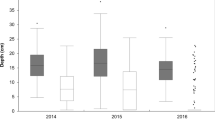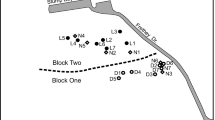Abstract
Grazing and burning are commonly applied practices that can impact the diversity and biomass of wetland plant communities. We evaluated the vegetative response of wetlands and adjacent upland grasslands to four treatment regimes (continuous idle, fall prescribed burning followed by idle, annual fall cattle grazing, and rotation of summer grazing and idle) commonly used by the U.S. Fish and Wildlife Service. Our study area was Grays Lake, a large, montane wetland in southeastern Idaho that is bordered by extensive wet meadows. We identified seven plant cover types, representing the transition from dry meadow to deep wetland habitats: mixed deep marsh, spikerush slough, Baltic rush (Juncus balticus), moist meadow, alkali, mesic meadow, and dry meadow. We compared changes in community composition and total aboveground biomass of each plant cover type between 1998, when all units had been idled for three years, and 1999 (1 yr post-treatment) and 2000 (2 yr post-treatment). Analysis using non-metric multidimensional scaling indicated that compositional changes varied among cover types, treatments, and years following treatment. Treatment-related changes in community composition were greatest in mixed deep marsh, Baltic rush, and mesic meadow. In mixed deep marsh and Baltic rush, grazing and associated trampling contributed to changes in the plant community toward more open water and aquatic species and lower dominance of Baltic rush; grazing and trampling also seemed to contribute to increased cover in mesic meadow. Changing hydrological conditions, from multiple years of high water to increasing drought, was an important factor influencing community composition and may have interacted with management treatments. Biomass differed among treatments and between years within cover types. In the wettest cover types, fall burning and grazing rotation treatments had greater negative impact on biomass than the idle treatment, but in drier cover types, summer grazing stimulated biomass production. Our results illustrate the spatial and temporal complexity of the transition between dry meadow and wetland habitats, and variable interactions among plant communities, treatments, and annual wetland conditions.
Similar content being viewed by others
Literature Cited
Allen-Diaz, B. H. 1991. Water table and plant species relationships in Sierra Nevada meadows. American Midland Naturalist 126: 30–43.
Anderson, E. W. and W. F. Currier. 1973. Evaluating zones of utilization. Journal of Range Management 26: 87–91.
Austin, J. E., J. R. Keough, and W. H. Pyle. 2004. Effects of habitat management practices on plant cover types of uplands and wetlands at Grays Lake National Wildlife Refuge, Idaho, 1997–2000. Report submitted to U.S. Fish and Wildlife Service. U. S. Geological Survey, Northern Prairie Wildlife Research Center, Jamestown, ND, USA.
Austin, J. E. and W. H. Pyle. 2004. Nesting ecology of waterbirds at Grays Lake, Idaho. Western North American Naturalist 64: 277–92.
Bernard, J. M. 1974. Seasonal changes in standing crop and primary production in a sedge wetland and an adjacent dry oldfield in central Minnesota. Ecology 55: 350–59.
Bernard, J. M., D. Solander, and J. Kvet. 1988. Production and nutrient dynamics in Carex wetlands. Aquatic Botany 30: 125–47.
Bowles, M., J. McBride, N. Stoynoff, and K. Johnson. 1996. Temporal changes in vegetation composition and structure in a fire-managed prairie fen. Natural Areas Journal 16: 275–88.
Boyd, R. S., R. A. Woodward, and G. Walter. 1993. Fire effects on a montane Sierra Nevada meadow. California Fish and Game 79: 115–25.
Brower, J., J. Zar, and C. von Ende. 1990. Field and Laboratory for General Ecology, third edition. William C. Brown Publishing, Dubuque, IA, USA.
Castelli, R. M., J. C. Chambers, and R. J. Tausch. 2000. Soilplant relations along a soil-water gradient in Great Basin meadows. Wetlands 20: 251–66.
Chambers, J. C., R. R. Blank, D. C. Zamudio, and R. J. Tausch. 1999. Central Nevada riparian areas: physical and chemical properties of meadow soils. Journal of Range Management 52: 92–99.
Cronquist, A., A. H. Holmgren, N. H. Holmgren, and J. L. Reveal. 1992–1994. Intermountain Flora. Volumes 1–5. New York Botanical Garden, New York, NY, USA.
DeBano, L. F., D. G. Neary, and P. F. Ffolliott. 1998. Fire Effects on Ecosystems. John Wiley and Sons, Inc., New York, NY, USA.
Dobkin, D. S., A. C. Rich, and W. H. Pyle. 1998. Habitat and avifaunal recovery from livestock grazing in a riparian meadow system of the northwestern Great Basin. Conservation Biology 12: 209–21.
Dwire, K. A., J. B. Kauffman, and J. E. Baham. 2006. Plant species distribution in relation to water-table depth and soil redox potential in montane riparian meadows. Wetlands 26: 131–46.
Dwire, K. A., J. B. Kauffman, E. N. J. Brookshire, and J. E. Baham. 2004. Plant biomass and species composition along an environmental gradient in montane riparian meadows. Oecologia 139: 300–17.
Gabrey, S. W. and A. D. Afton. 2001. Plant community composition and biomass in Gulf Coast Chenier Plain marshes: responses to winter burning and structural marsh management. Environmental Management 27: 281–93.
Gammonley, J. H. 1996. Seasonal use of montane wetlands by waterbirds on the Rim of the Colorado Plateau. Ph.D. Dissertation. University of Missouri, Columbia, MO, USA.
Gorham, E. and M. G. Somers. 1973. Seasonal changes in standing crop of two montane sedges. Canadian Journal of Botany 51: 1097–1108.
Green, D. M. and J. B. Kauffman. 1995. Succession and livestock grazing in a northeastern Oregon riparian ecosystem. Journal of Range Management 48: 307–13.
Greig-Smith, P. 1983. Quantitative Plant Ecology, third edition. Blackwell Scientific Publications, Oxford, UK.
Hitchcock, C. L. 1973. Flora of the Pacific Northwest; An Illustrated Manual. University of Washington Press, Seattle, WA, USA.
Hoff, T. M. 1993. Effects of cattle grazing on waterfowl nesting cover in Arizona montane wetlands. M.S. Thesis. Northern Arizona University, Tucson, AZ, USA.
Humphrey, J. W. and G. S. Patterson. 2000. Effects of late summer cattle grazing on the diversity of riparian pasture vegetation in an upland conifer forest. Journal of Applied Ecology 37: 986–96.
Idaho State Climate Services. 2004. http://snow.ag.uidaho.edu.Last Accessed 8 Jan 2004.
Johnson, S. R. and A. K. Knapp. 1993. The effect of fire on gas exchange and aboveground biomass production in annually vs. biennially burned Spartina pectinata wetlands. Wetlands 13: 299–303.
Kauffman, J. B., W. C. Krueger, and M. Vavra. 1983. Effects of late season cattle grazing on riparian plant communities. Journal of Range Management 36: 685–91.
Kirby, R. E., J. K. Ringelman, D. R. Anderson, and R. S. Sojda. 1992. Grazing on national wildlife refuges: do the needs outweigh the problems? Transactions of the North American Wildlife and Natural Resources Conference 57: 613–26.
Korpela, E. J. 1992. Modeling riparian zone processes: biomass production and grazing. Ph.D. Dissertation. Oregon State University, Corvallis, OR, USA.
Kost, M. A. and D. De Steven. 2000. Plant community responses to prescribed burning in Wisconsin sedge meadows. Natural Areas Journal 20: 36–45.
Leege, T. A., D. J. Herman, and B. Zamora. 1981. Effects of cattle grazing on mountain meadows. Journal of Range Management 34: 324–28.
Marston, R. A. and J. E. Anderson. 1991. Watersheds and vegetation of the Greater Yellowstone Ecosystem. Conservation Biology 5: 338–46.
Martin, D. W. and J. C. Chambers. 2001. Effects of water table, clipping, and species interactions on Carex nebrascensis and Poa pratensis in riparian meadows. Wetlands 21: 421–30.
McCune, B. and M. J. Mefford. 1999. PC-ORD. Multivariate Analysis of Ecological Data. Version 4. MJM Software Design, Gleneden Beach, OR, USA.
Middleton, B. 2002. Winter burning and the reduction of Cornus sericea in sedge meadows in southern Wisconsin. Restoration and Management Notes 10: 723–30.
Mitchell, W. A. and H. G. Hughes. 1995. Point sampling. Section 6.2.1, U.S. Army Corps of Engineers Wildlife Resources Management Manual, Technical Report EL-95-25.
Mitsch, W. J. and J. G. Gosselink. 2000. Wetlands, third edition. John Wiley and Sons, Inc., New York, NY, USA.
Mueggler, W. F. 1983. Variation in production and development of mountain grasslands in western Montana. U.S. Department of Agriculture, Forest Service, Intermountain Forest and Range Experiment Station Research Paper INT-316.
Noy-Meir, I., N. Gutman, and Y. Kaplan. 1989. Responses of Mediterranean grassland plants to grazing and protection. Journal of Ecology 77: 290–310.
Patton, D. R. and B. I. Judd. 1970. The role of wet meadows as wildlife habitat in the southwest. Journal of Range Management 23: 272–75.
Ratliff, R. D. and S. E. Westfall. 1987. Dry-year grazing and Nebraska sedge (Carex nebrascensis). Great Basin Naturalist 47: 422–26.
Reynolds, H. L. 1999. Plant interactions: competition. p. 649–76. In F. I. Pugnaires and F. Valladores (eds.) Handbook of Plant Ecology. Marcel Dokker, Inc., New York, NY, USA.
Roath, L. R. and W. C. Krueger. 1982. Cattle grazing and behavior on a forested range. Journal of Range Management 35: 332–38.
SAS Institute, Inc. 1999. SAS OnlineDoc, Version 8. SAS Institute, Inc., Cary, NC, USA.
SAS Institute. 2002. SAS OnlineDoc, Version 9.1. SAS Institute, Inc., Cary, NC, USA.
Sanders, R. L. 1997. Montane wetland characteristics and waterfowl use on the Routt National Forest, Colorado. M.S. Thesis. University of Missouri, Columbia, MO, USA.
Schmalzer, P. A., C. R. Hinkle, and J. L. Mailander. 1991. Changes in community composition and biomass in Juncus roemerianus Scheele and Spartina bakeri Merr. marshes one year after a fire. Wetlands 11: 67–86.
Schulz, T. T. and W. C. Leininger. 1990. Differences in riparian vegetation structure between grazed areas and exclosures. Journal of Range Management 43: 295–98.
Steel, P. E. 1952. Factors affecting waterfowl production at Gray’s Lake, Idaho. M.S. Thesis. University of Idaho, Moscow, ID, USA.
Stohlgren, T. J., L. D. Schell, and B. Vanden Heuvel. 1999. How grazing and soil quality affect native and exotic plant diversity in Rocky Mountain grasslands. Ecological Applications 9: 45–64.
U.S. Fish and Wildlife Service. 1982. Master plan report for Grays Lake National Wildlife Refuge, Wayan, Idaho. U.S. Fish and Wildlife Service, Portland, OR, USA.
van der Valk, A. G. and C. B. Davis. 1979. A reconstruction of the recent vegetational history of a prairie marsh, Eagle Lake, Iowa, from its seed bank. Aquatic Botany 6: 29–51.
Volland, L. A. 1978. Trends in standing crop and species composition of a rested Kentucky bluegrass meadow over an 11 year period, p. 526–29. In D. N. Hyder (ed.) Proceedings International Range Congress. Denver, Colorado, USA.
Weixelman, D. A., D. C. Zamudio, and K. A. Zamudio. 1996. Central Nevada Riparian Field Guide. U.S. Department of Agriculture, Forest Service Region 4 Ecology 96–01. Intermountain Region, Ogden, UT, USA.
Western Regional Climate Center. 2002. Idaho climate summaries. Henry, Idaho (104230). National Oceanographic and Atmospheric Administration, Western Region Climate Center, Reno, NV. http://www.wrcc.dri.edu/cgi-bin/cliMAIN.pl?idhenr.(Vers25 Jan03).
Windell, J. T., B. E. Willard, D. J. Cooper, S. Q. Foster, C. F. Knud-Hanson, L. P. Rink, and G. N. Kiladis. 1986. An ecological characterization of Rocky Mountain montane and subalpine wetlands. U.S. Fish and Wildlife Service Biological Report 86(11).
Wishart, D. 1969. An algorithm for hierarchical classification. Biometrics 25: 165–70.
Young, R. P. 1987. Fire ecology and management in plant communities of Malheur National Wildlife Refuge, southeastern Oregon. Ph.D. Dissertation. Oregon State University, Corvallis, OR, USA.
Author information
Authors and Affiliations
Corresponding author
Rights and permissions
About this article
Cite this article
Austin, J.E., Keough, J.R. & Pyle, W.H. Effects of habitat management treatments on plant community composition and biomass in a Montane Wetland. Wetlands 27, 570–587 (2007). https://doi.org/10.1672/0277-5212(2007)27[570:EOHMTO]2.0.CO;2
Received:
Accepted:
Issue Date:
DOI: https://doi.org/10.1672/0277-5212(2007)27[570:EOHMTO]2.0.CO;2




